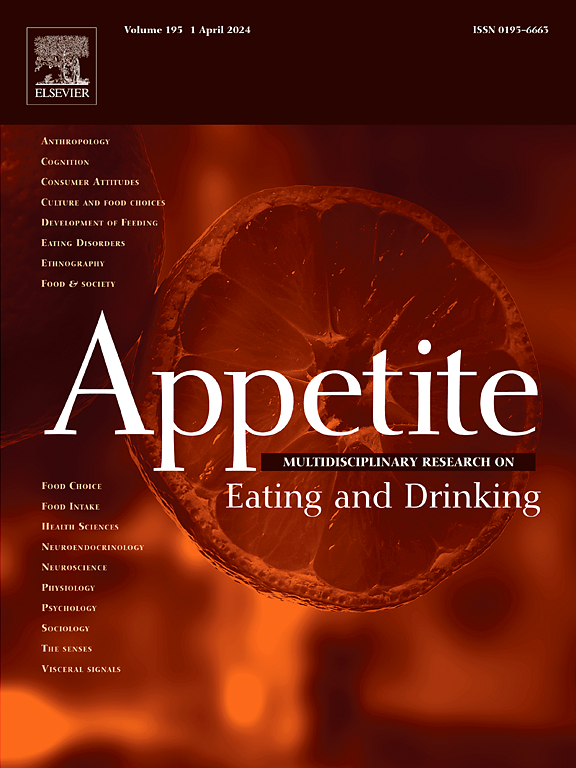Cerebellar stimulation influences performance to a food-related Go/NoGo task
IF 3.8
2区 医学
Q1 BEHAVIORAL SCIENCES
引用次数: 0
Abstract
The impulse for food is a well-rooted adaptive drive that implies not only the energetic sustenance of the organism but also hedonic-rewarding mechanisms. Inhibitory control is closely associated with decision-making which might moderate/mediate food choices/consumption. Growing evidence supports the involvement of the cerebellum in cognitive inhibitory control, and its role in eating and somato-visceral integration. The current research was aimed at directly investigating the physiological role of the cerebellum in food-related inhibitory control. In a within-subject design, the cerebellar activity of 23 healthy women was modulated by anodal, cathodal, and sham transcranial cerebellar Direct Current Stimulation (tcDCS) combined with the visual presentation of food images. Immediately after receiving combined tcDCS/visual stimulation, participants performed a food-related Go/NoGo task requiring them to react to or withhold a response to high-, low-calorie food and non-food images. All participants completed questionnaires regarding impulsivity traits (by Barratt Impulsiveness Scale-11) and weight concern (by Eating Disorder Examination Questionnaire and Eating Attitude Test). The results showed an increased omission rate following cathodal tcDCS, a positive correlation between omissions to food stimuli and psychological assessment of weight concern, and faster and more accurate responses to high-calorie food images. These findings support the cerebellar role in food-related inhibitory control and show that individual concerns about weight can affect Go/NoGo performance with food stimuli. Moreover, they underpin the existence of an implicit cognitive advantage for high-calorie (appetizing) food.
小脑刺激影响与食物相关的Go/NoGo任务的表现
对食物的冲动是一种根深蒂固的适应性驱动,它不仅意味着生物体的能量维持,而且意味着享乐奖励机制。抑制控制与决策密切相关,决策可能会调节/调节食物选择/消费。越来越多的证据支持小脑参与认知抑制控制,以及它在进食和躯体-内脏整合中的作用。目前的研究旨在直接探讨小脑在食物相关抑制控制中的生理作用。在受试者内设计中,23名健康女性的小脑活动通过阳极、阴极和假性经颅小脑直流电刺激(tcDCS)结合食物图像的视觉呈现来调节。在接受tcDCS/视觉联合刺激后,参与者立即执行与食物相关的Go/NoGo任务,要求他们对高热量、低热量食物和非食物图像做出反应或保留反应。所有参与者都完成了关于冲动特征(Barratt冲动性量表-11)和体重问题(饮食失调检查问卷和饮食态度测试)的调查问卷。结果表明,经阴极tcDCS后,受试者对食物刺激的疏漏率增加,对体重担忧的心理评估与食物刺激的疏漏呈正相关,对高热量食物图像的反应更快、更准确。这些发现支持小脑在食物相关抑制控制中的作用,并表明个体对体重的担忧会影响食物刺激下Go/NoGo的表现。此外,它们支持了对高热量(开胃)食物的隐性认知优势的存在。
本文章由计算机程序翻译,如有差异,请以英文原文为准。
求助全文
约1分钟内获得全文
求助全文
来源期刊

Appetite
医学-行为科学
CiteScore
9.10
自引率
11.10%
发文量
566
审稿时长
13.4 weeks
期刊介绍:
Appetite is an international research journal specializing in cultural, social, psychological, sensory and physiological influences on the selection and intake of foods and drinks. It covers normal and disordered eating and drinking and welcomes studies of both human and non-human animal behaviour toward food. Appetite publishes research reports, reviews and commentaries. Thematic special issues appear regularly. From time to time the journal carries abstracts from professional meetings. Submissions to Appetite are expected to be based primarily on observations directly related to the selection and intake of foods and drinks; papers that are primarily focused on topics such as nutrition or obesity will not be considered unless they specifically make a novel scientific contribution to the understanding of appetite in line with the journal's aims and scope.
 求助内容:
求助内容: 应助结果提醒方式:
应助结果提醒方式:


